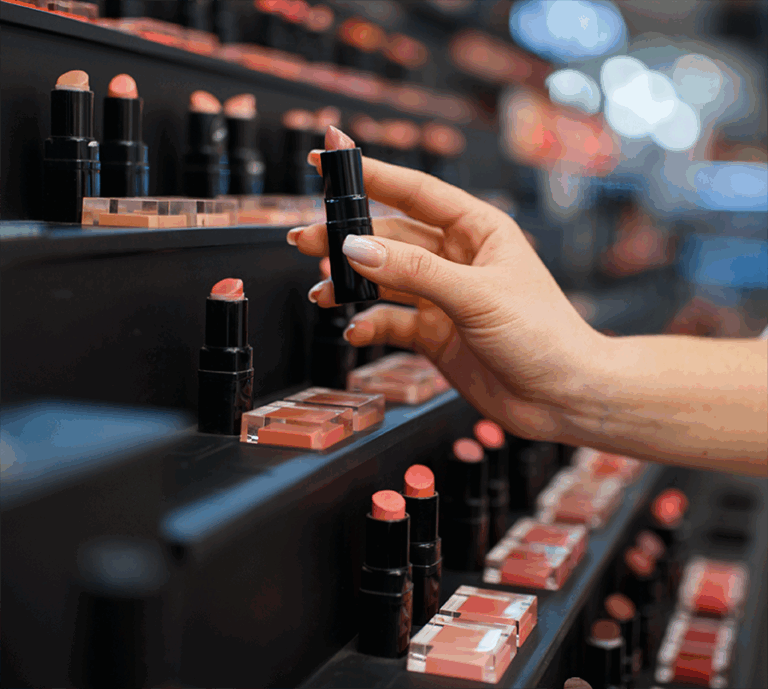×

There’s a growing gap in beauty retail that most brands don’t see coming. Our Director of Strategy, Alexa Jewell Schaefer, shares more in VMSD.

Caitlin Neyer, Director of Strategic Partnerships at ChangeUp, looks at the prospects of beauty business’ rebound, rising trends, and in-store opportunities.
Besides restaurants, few industries will be facing long-term impacts from COVID-19 as severe as the beauty sector. According to worldwide consulting and research firm Kline, the U.S. cosmetics market is on track to experience the sharpest decline ever recorded in over 60 years.
While the future is uncertain, there’s no denying that beauty retail will need to make changes. As a thought-starter for engaging with a cautious customer, we identified six themes and execution ideas that will rejuvenate the beauty industry, while making the retail experience better.
Wiping down shopping carts and sanitizing checkout lanes is now standard practice for grocery and mass retailers. It is a process that is both functional (it kills germs) and emotional (it puts customers at ease). While specialty beauty retailers don’t rely on shopping carts or deal with as high traffic checkouts, a commitment to cleanliness will still be vitally important. In the beauty space, there is an opportunity to transform sanitization from a must-do task for employees into positive, memorable moments for the customer.
Imagine as a customer enters the store; she is greeted with a complimentary pump of hand sanitizer. Not just any sanitizer either, rather an upscale hand rinse from a boutique brand. After completing her shopping, she is offered sanitizer again – only this time with a moisturizer to help nourish her skin and offset the effects of constant hand-washing.
Consumers will likely be apprehensive about engaging with beauty retailers, given the intimate and highly social experience with service providers such as makeup artists, hairstylists, or nail techs. Historically, the client/provider relationship has been one of high-trust – “Sure, add some highlights, I trust you,” or “I don’t usually wear a bold lipstick, but if you say so.” Thanks to the pandemic, the world is filled with mistrust of individuals, regardless of their expertise. “Did they wash their hands? Did they wear a mask at the store?”
While some retailers already have sinks as part of their experience, we anticipate seeing additional retailers adding a cleansing moment as part of their in-store ritual. Rather than tucking an employee-only sink back-of-house, hand-washing can become a new moment of trial for the consumer (while simultaneously building confidence in the employee and the brand).
One of physical retail’s greatest strengths has always been its ability to deliver a sensorial environment. There is a level of uncertainty about purchasing beauty products online. “Does the shade match me?” or “will I like the texture or smell?” are all questions that are tough to answer when shopping from a screen.
As a signature in-store experience, beauty retailers will need to alter the way products are sampled immediately. Consumers will be hesitant to handle products if they’re not sure who touched it last – let alone apply an unfamiliar product directly to their skin. Packaging design must shift to focus on safety for at-home use, and in-store testers should follow suit with minimal-touch solutions. Trial is critical to driving purchase in-store and will remain the key focus for retailers to re-engage customers.
Using digital technology to enhance online cosmetic shopping was on the rise before the pandemic and will only increase in the coming months. Digital Makeovers and Virtual Artists are tools that customers are becoming more comfortable exploring and confident in using. We anticipate these tools to be scaled up even further within the physical store environment as a way to safely try products while engaging with a store associate (at a distance). We’ve also seen an increase in content and product development designed to be consumed at home. Communicating these offerings with customers as they re-enter stores will be vital to easing them back into high-touch service engagements.
As we’ve seen from the empty home essentials shelves, consumers are hyper-focused on cleanliness. While ensuring customers that retail is delivering a sanitized experience is critical, making these sanitizing efforts relatively inconspicuous is a crucial part of getting back to “normal.” Shopping for cosmetics and skincare is a moment of self-care and should feel like a worry-free escape.
Consider redesigning high-touch fixtures to make them easier to clean, maybe even incorporating self-sanitizing technology. The longer we emphasize constant wipe-down procedures, the longer consumers will feel that shopping is a germ obstacle course instead of a fun, enjoyable activity.
Consumers have become acutely aware of their health and have an increased desire to achieve results from the inside out. The beauty industry is no longer solely defined as cosmetics, rather a more holistic approach to feeling confident. As such, retailers may consider expanding to a space of health & wellness, offering supplements, vitamins, and exercise classes directly or through partnerships. By understanding the customer’s headspace and adjusting the experience accordingly, retailers can cast themselves in a fresh light.
We’ll see an evolution of cleanliness as a clinical and functional process, to indulgent and participatory one. Significant changes are on the horizon for all aspects of retail, but the potential new environment within the beauty space might just get the next five-star review.


